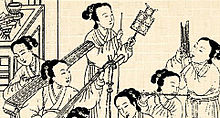- Yayue
-
Music of China 
Timeline General topics Genres Specific forms - Taoist music
- Yayue
Media and performance Music festivals Midi Modern Music Festival Music media National anthem Regional music Yayue (Chinese: 雅樂, literally "elegant music" (雅=elegant, 樂=music), Wade-Giles ya-yüeh; Japanese: 雅楽; Korean: 아악; Vietnamese: Nhã Nhạc) was originally a form of Chinese classical music that was performed at imperial courts. The basic conventions of yayue were established in the Western Zhou. Together with law and rites, it formed the formal representation of aristocratic political power. Yayue has also seen its influence in other parts of East Asia, notably the gagaku in Japan, aak in Korea, and nhã nhạc in Vietnam.
According to tradition, yayue was created by the Duke of Zhou under commission from King Wu of Zhou, shortly after the latter's conquest of Shang. Incorporated within yayue were elements of shamanistic or religious traditions, as well as early Chinese folk music.
The Classic of Rites records a number of situations where yayue might be performed. These included ceremonies in honour of Heaven and Earth, the gods or the ancestors. There were also detailed rules on the way they were to be performed at diplomatic meetings. Yayue was also used in outdoor activities, such as aristocratic archery contests, during hunting expeditions, and after the conclusion of a successful military campaign. Yayue was characterised by its rigidity of form. When performed, it was stately and formal, serving to distinguish the aristocractic classes. It was sometimes also accompanied by lyrics. Some of these are preserved in the Book of Songs.
With the decline of the importance ceremony in the interstate relations of the Spring and Autumn Period, so did yayue. Marquis Wen of Wei, for example, was said to prefer the folk music of Wei and Zheng to court music, listening to which he habitually fell asleep. Confucius famously lamented the downfall of classical music and the rites.
Some form of yayue still survived for imperial ceremonies and rituals until the fall of the Qing Dynasty when it was eventually lost without imperial patronage to preserve it.
Contents
Instruments used
Traditional Chinese musical instruments comprise a wide range of string instruments (both bowed and plucked), wind instruments, and percussion instruments. Traditionally, they were also classified according to the materials used in their construction.
Silk (絲)
- Guqin (Chinese: 古琴; pinyin: gǔqín) - Seven-stringed fretless zither
- Se (Chinese: 瑟; pinyin: sè) - 25 stringed zither with moveable bridges (ancient sources say 13, 25 or 50 strings)
- Yazheng (牙箏) - Bowed zither
- Zhu (筑) - Ancient zither, struck or plucked with a stick
Bamboo (竹)
- Dizi (笛子) - Transverse bamboo flute with buzzing membrane
- Xiao (簫) - End-blown flute
- Paixiao (simplified Chinese: 排箫; traditional Chinese: 排簫) - Pan pipes
- Chi (篪) - Ancient Chinese flute
- Guan (Chinese: 管; pinyin: guǎn) - A cylindrical double reed wind instrument
Wood (木)
- Zhu (Chinese: 柷; pinyin: zhù) - A wooden box that tapers from the bottom, played by hitting a stick on the inside, used to mark beats or sections
- Yu (Chinese: 敔; pinyin: yǔ) - A wooden percussion instrument carved in the shape of a tiger with a serrated back, played by running a stick across it and to mark the ends of sections
Stone (石)
- Bianqing (simplified: 编磬; traditional: 編磬; pinyin: biānqìng) - A rack of hung stone tablets struck using a mallet
Metal (金)
- Bianzhong (編鐘) - 65 bronze bells hung on a rack, struck using poles
- Fangxiang (simplified Chinese: 方响; traditional Chinese: 方響; pinyin: fang1 xiang3; Wade–Giles: fang hsiang) - A set of tuned metal slabs (metallophone)
Clay (土)
Gourd (匏)
- Sheng (Chinese: 笙; pinyin: shēng) - A free reed mouth organ consisting of varying number of bamboo pipes inserted into a gourd chamber with finger holes
- Yu (Chinese: 竽; pinyin: yú) - An ancient free reed mouth organ similar to the sheng but generally larger
Hide (革)
- Gu - (鼓) - Drum
Yayue in East Asia
In Chinese, Japanese, Korean, and Vietnamese,when written in Chinese characters (漢字), Yayue '雅樂' is pronounced differently in the four languages.
Yayue in Japan
Main article: gagakuGagaku is a type of Japanese classical music that has been performed at the Imperial court for several centuries. It consists of native Shinto religious music and folk, a Goguryeo and Manchurian form, called komagaku, and a Chinese and South Asia form, called togaku.
Yayue in Korea
Main article: AakIn Korean, Yayue (雅樂) is called '아악' (Aak).아=雅, 악=樂.
Yayue in Vietnam
Main article: Nhã nhạcIn Vietnam, Yayue (雅樂) is called 'Nhã nhạc'.Nhã=雅, nhạc=樂.
See also
Categories:- Chinese music
- Chinese traditional music
Wikimedia Foundation. 2010.
